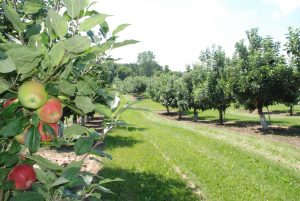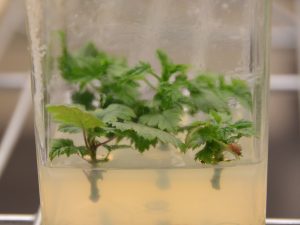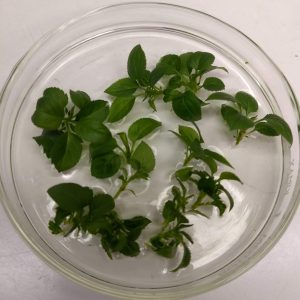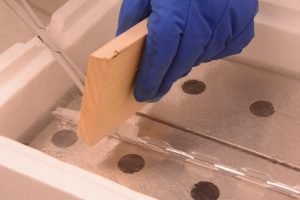Apple Shoot Tip Cryopreservation
Jean Carlos Bettoni, The New Zealand Institute for Plant & Food Research Limited, Private Bag 11 600, Palmerston North, 4442, New Zealand.
Remi Bonnart, USDA-ARS National Laboratory for Genetic Resources Preservation, 1111 S. Mason St., Fort Collins, Colorado 80521.
Gayle M. Volk, USDA-ARS National Laboratory for Genetic Resources Preservation, 1111 S. Mason St., Fort Collins, Colorado 80521. Gayle.Volk@usda.gov
Outline
- Introduction
- Shoot tip excision
- Shoot tip processing and liquid nitrogen exposure
- Long-term storage
- Viability assessment
- References
- Additional information
- Acknowledgments
The Malus shoot tip cryopreservation procedure is available for download here.
1. Introduction
The USDA-ARS National Plant Germplasm System has a collection of apple (Malus) genetic resources maintained at the Plant Genetic Resources Unit in Geneva, New York (Fig. 1). The collection includes field plantings, a few trees in the greenhouse, as well as seeds in cold storage. In addition, 2052 Malus accessions are backed-up as dormant buds in the base collection at the National Laboratory for Genetic Resources Preservation (NLGRP) in Fort Collins, Colorado (Volk et al., 2017, also see “Cryopreservation of Dormant Apple Buds“). A method for cryopreserving Malus shoot tips was developed at the NLGRP to preserve some apple genetic resources in liquid nitrogen as well as for use in cryotherapy applications.
Figure 1. Malus in the NPGS field collection in Geneva, New York. Photo credit: Gayle Volk.
2. Shoot tip excision
Malus in vitro stock cultures (Fig. 2) are maintained in an actively growing state on Multiplication Medium (MS + 30 g L-1 sucrose + 0.1 g L-1 myo-inositol, 1 mg L-1 6-benzyl aminopurine (BAP), 0.3 mg L-1 indole-3-butyric acid (IBA), 0.2 mg L-1 gibberellic acid and 7.5 agar at pH 5.5 (pH 5.8 prior to autoclaving)) in growth room at 25 oC with a 16 h photoperiod (40 μM m-2 s-1) and subcultured once every 4 weeks. Apical shoot tips (1.5 mm) are harvested from 4-week-old in vitro stock cultures and plated on Basal Medium (MS + 30 g L-1 sucrose + 0.25 mg L-1 BAP + 0.01 mg L-1 IBA + 2.6 g L-1 gellan gum at pH 5.7 (pH 6.0 prior to autoclaving)) overnight at 25 oC in darkness. This process is shown in Video 1.
Figure 2. Magenta cube with in vitro-grown Malus (left) and Malus plants removed from culture and ready for shoot tip excision (right). Photo credit: Gayle Volk (left) and Jean Bettoni (right).
Video 1. Excision of Malus shoot tips, demonstrated by Jean-Carlos Bettoni (Plant and Food New Zealand) and narrated by Remi Bonnart (NLGRP).
3. Shoot tip processing and liquid nitrogen exposure
After the overnight incubation, shoot tips are transferred from Basal Medium and placed onto Preculture Medium (MS + 2 M glycerol + 0.8 M sucrose + 7.5 g L-1 agar at pH 5.8 (pH 6.4 prior to autoclaving)). They are then precultured for 1 day at 25 oC in darkness. The shoot tips are then transferred from Preculture Medium and treated with full-strength PVS2 (1/2-strength MS + 30% (w/v) glycerol + 15% (w/v) ethylene glycol + 15% (w/v) dimethyl sulfoxide + 0.4 M sucrose at pH 5.8 (filter sterilized solution); Sakai et al., 1990) at room temperature for 20-40 minutes (40 minutes has been the most effective time for most species/cultivars). Shoot tips are then placed into a very thin layer of PVS2 on foil strips and plunged into LN. The foil strips are transferred to cryovials in a frozen state. This process is demonstrated in Video 2.
Video 2. Video of the transfer of shoot tips from Malus Preculture Medium into PVS2, followed by the cryopreservation process using a droplet vitrification technique on foil strips, demonstrated by Jean-Carlos Bettoni (Plant and Food New Zealand) and narrated by Remi Bonnart (NLGRP).
4. Long-term storage
Cryovials are placed onto cryocanes (Fig. 3), which are then placed into labeled sleeves in cans. They are then maintained in the liquid or vapor phase of liquid nitrogen for long-term storage (Fig. 4; Video 3). A total of 170 shoot tips are processed per accession, with 10 shoot tips placed on each foil, and one foil placed into each cryovial. Fifteen cryovials (of 10 shoot tips each) are cryopreserved in the base collection and the shoot tips within two cryovials are warmed for viability assessments. Cryovials with shoot tips are transferred from the dewar to the liquid nitrogen tanks for long-term storage.
Figure 3. Cryovials are loaded onto cryocanes for long-term storage. Photo credit: Gayle Volk.
Figure 4. Aluminum cryoboxes in the vapor phase of liquid nitrogen. Photo credit: Gayle Volk.
Video 3. Transfer of cryovials to cryotank for long-term storage, demonstrated by Jean-Carlos Bettoni (Plant and Food New Zealand) and narrated by Remi Bonnart (NLGRP).
5. Viability assessment
Cryovials are removed from LN and foil strips are immediately placed in room temperature Unloading Solution (MS + 1.2M sucrose at pH 5.7 (pH 6.6 prior to autoclaving)) and held for 20 minutes. The shoot tips are then plated onto Basal Medium and incubated overnight at 25 oC in darkness (Video 4). Next, the shoot tips are transferred to fresh Basal Medium and cultured for 7 days at 25 oC in darkness, after which they are put into light conditions in the culture room at 25 oC. Shoot tips are evaluated for survival and/or recovery after 8 weeks (Fig. 5), and transferred to fresh medium as needed.
Video 4. Warming and plating cryopreserved Malus shoot tips, demonstrated by Jean-Carlos Bettoni and narrated by Remi Bonnart.
Figure 5. Malus plants grown from cryopreserved shoot tips. Photo credit: Jean Bettoni.
6. References
Li B, Feng C, Wang M, Hu L, Volk G, Wang Q. 2015. Recovery patterns, histological observations and genetic integrity in Malus shoot tips cryopreserved using droplet-vitrification and encapsulation-dehydration procedures. Journal of Biotechnology 214:182-191.
Sakai A, Kobayashi S, Oiyama I. 1990. Cryopreservation of nucellar cells of navel orange (Citrus sinensis Osb. Var. Brasiliensis Tanaka) by vitrification. Plant Cell Rep. 9(1):30-33. doi: 10.1007/BF00232130
Souza JA, Bogo A, Bettoni JC, Dalla Costa M, da Silva FN, Casa RT, Rufato L. 2020. Droplet-vitrification cryotherapy for eradication of apple stem grooving virus and apple stem pitting virus from “Marubakaido” apple rootstock. Tropical Plant Pathology. https://doi.org/10.1007/s40858-019-00321-z
Volk GM, Jenderek M, Chao CT. 2014. Prioritization of Malus accessions for collection cryopreservation at the USDA-ARS National Center for Genetic Resources Preservation. Acta Horticulturae 112:267-272.
Wang M, Chen L, Teixeira da Silva JA, Volk GM, Wang Q. 2018. Cryobiotechnology of apple (Malus spp.): development, progress and future prospects. Plant Cell Reports 37:689-709.
7. Additional information
The apple shoot tip cryopreservation procedure is available for download here.
8. Acknowledgments
Citation: Bettoni J, Bonnart R, Volk GM. 2020. Malus Shoot Tip Cryopreservation. In: Volk GM (Eds.) Training in Plant Genetic Resources: Cryopreservation of Clonal Propagules. Fort Collins, Colorado: Colorado State University. Date accessed. Available from https://colostate.pressbooks.pub/clonalcryopreservation/chapter/apple-shoot-tip-cryopreservation/
This training module was made possible by:
Editors: Emma Balunek, Gayle Volk
Content providers: Jean-Carlos Bettoni, Remi Bonnart, Gayle Volk
Videographers: Mike May, Remi Bonnart
This project was funded by the USDA-ARS and in part by the National Academy of Sciences (NAS) and USAID, and any opinions, findings, conclusions, or recommendations expressed in such are those of the authors alone, and do not necessarily reflect the views of USAID or NAS. USDA is an equal opportunity provider, employer, and lender. Mention of trade names or commercial products in this article is solely for the purpose of providing specific information and does not imply recommendation or endorsement by the U.S. Department of Agriculture.








